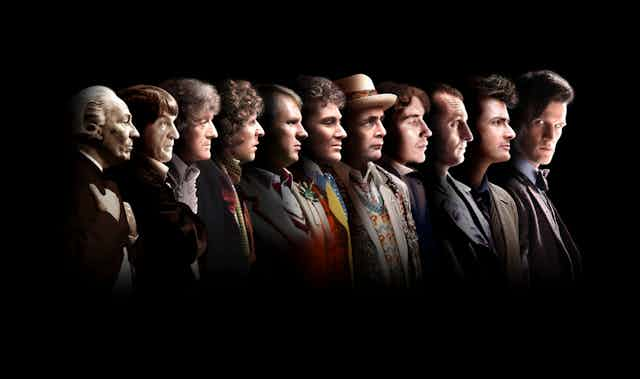The announcement the BBC will move the global streaming of Doctor Who from free to air channels to Disney+ will change the viewing habits for millions of people internationally.
In Australia, Doctor Who will be removed from the ABC, in New Zealand from TVNZ, and in America from BBC America.
According to reports, the BBC and Disney+ are thrilled with the deal. The show’s chief writer Russell T. Davies has said this new relationship will allow the show to “launch the TARDIS all around the planet, reaching a new generation of fans while keeping our traditional home firmly on the BBC in the UK.”
But what about the traditional homes Doctor Who has in other countries, which often kept rare Doctor Who episodes safe which the BBC discarded in the 1970s, before the BBC began archiving the videotapes of their old black and white programs. Now the BBC keeps everything, but once wiped or threw out tapes when they thought the programs had no further value.
Black and white broadcasting for the world
The first people anywhere in the world to see Doctor Who were British viewers of the BBC’s television service on November 23 1963. Any one with a television licence could have watched and several million people did, having just learned of President John F Kennedy’s assassination.
The rest of the world did not have to wait long. In the mid-1960s television was mostly black and white and the BBC’s 405 line productions could be broadcast by technicians in television stations around the world.
West Australians first saw Doctor Who in January 1965. Shortly after, the ABC in other capitals began to broadcast the series.
The global broadcasting of Doctor Who has created different viewing patterns for diverse audiences.
Famously in Britain, Doctor Who was part of a Saturday evening “tea time” experience for school children: a line-up of football, light entertainment and drama from early afternoon to late night. Doctor Who kept its place as the mainstay of the BBC’s Saturday line-up almost without interruption from 1963 to 1989.
But for Australians like me, Doctor Who was viewed in a different way. As a child of the 1980s, Doctor Who was in an unmissable weekday afternoon line-up on the ABC.
Australians weren’t watching exactly the same episodes as their counterparts watching the BBC. Early Doctor Who is startlingly violent, and early on the show gained its enduring reputation as so scary kids watched from behind the sofa. These black and white episodes feature mass killings, hangings, shootings, attempted and actual rape, psychotic attacks by a scissor wielding woman, and more.
Doctor Who episodes broadcast in Australia in the 1960s and 1970s had many of these juicy moments were edited out by the Commonwealth Film Censorship Board.
Oddly, this means Australian television archives contain snippets of 1960s episodes still missing from the BBC archives, among them the existentially dreadful attack from Mr Oak and Mr Quill, humanoids made of gas who advance on a helpless woman breathing poison gas out of gaping black holes in their faces. These small moments of violence are all that’s left of some classics stories.
Global audiences from the 1960s to present
These snippets of missing episodes exist because, prior to the late 1970s, the BBC did not routinely archive its shows – including Doctor Who. Indeed, a global network of television archives has been crucial in maintaining the nearly 50 year history of the show.
Doctor Who episodes missing from the BBC archives have been recovered from Australia, New Zealand, Hong Kong and Africa. They were found there because the BBC sent them there, as exports for showing on local free to air channels.
As recently as 2013, a large number of missing episodes were found in a remote television relay station in west Africa.
Much academic research into the viewing and reception of Doctor Who is about British audiences. How fascinating it would be to know more about the first global audiences and the viewing reactions and audiences from Hong Kong to Nigeria.
Modern Doctor Who’s global audience is no less diverse. In 2013 the incumbent Doctor, Peter Capaldi, embarked on a world tour and fans in Seoul, Mexico City, Rio de Janeiro, New York and Sydney clamoured to meet him.
But these fans, like others elsewhere in the world, watched their favourite show free to air.
Read more: My time as a 'scary girl' on Doctor Who
Streaming the 60th anniversary and beyond
The BBC’s announcement changes everything for fans around the world.
It puts Doctor Who on par with programs from the streaming giants which are the most talked about in popular culture, like House of the Dragon or The Crown.
But Doctor Who has always been an accessible commodity on the ABC, TVNZ and their like.
In Australia, Doctor Who on the ABC was simply a fact of life. This announcement will not only be a disappointment but a concern about access.
It also means Doctor Who will be judged against lavish programs with immensely larger budgets, different storytelling approaches and multinational casts.
In 2021, the Guardian writer Martin Belam suggested the time had come to exterminate Doctor Who for precisely these reasons, but back then the show was still safe on global free to air.
This change means Doctor Who will enter its 60th year with its global broadcasting changed beyond recognition and judged against the giants of streamed television.
Read more: A fragmented streaming video market is good for everyone but the consumer
Correction: An earlier version of this story misnamed the New Zealand broadcaster. It is TVNZ.

